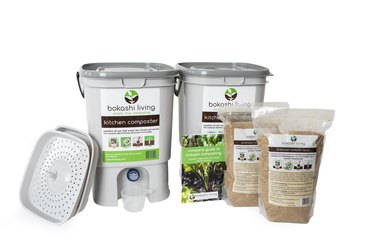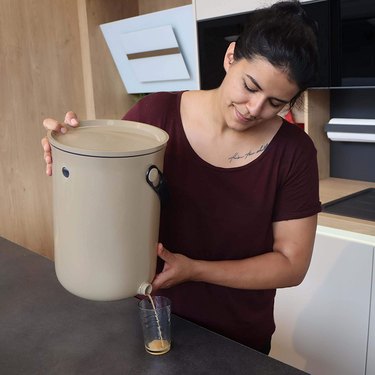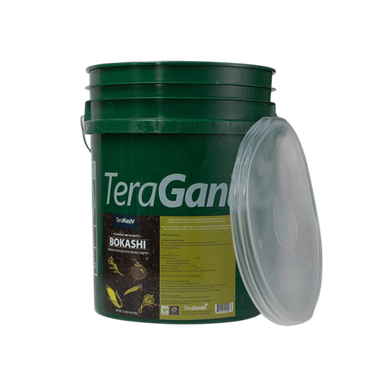When is a composter not a composter? When it is a bokashi bucket system. Using a bokashi bin is an ancient Japanese method of reducing the amount of food waste. This type of "composting" actually just ferments the food waste, but that makes it quite easy to compost the pickled detritus in the garden more quickly.
A bokashi bin looks like a small bucket and comes with a lid. It usually has a spigot at the base through which you can drain out the liquid, termed "bokashi tea," and use it for fertilizing container plants. Just layer the green material with a sprinkle of bran over it and a little water. Repeat with more layers until the bin can hold no more. Once the kitchen scraps are fermented in about two weeks, they are buried outside, and they turn into compost quickly and efficiently. The whole process takes four weeks or less.
Video of the Day
Video of the Day
1. Skaza Bokashi Organko 2
Giving the bokashi bucket a try is easy with the Skaza Bokashi Organko 2. This is a kitchen compost beginner setup with everything you need to get started. The kit includes an inner and outer container and lid as well as a carrying strap, a bag of bran and an instruction manual.
Pros:
- The kit contains everything you need to get started.
- The classic design is attractive, and unlike many bokashi bins, it has no labels or advertising on the bin.
- This bokashi kit is sturdy and durable since both the inside and outer bin are constructed of recycled plastic.
- The drain system to extract the bokashi tea is simple and efficient with a screw-off spigot.
Cons:
- The company indicates that the instruction manual might not be in English.
- At over $130, it's expensive.
Takeaway:
- The Skaza is a very attractive bin and doesn't look out of place in a well-appointed kitchen. This is not the case with many of these kits.
2. SCD Probiotics B100 All Seasons Indoor Composter
Not every bokashi system costs an arm and a leg, and this one is reasonable at just under $50. The SCD Probiotics B100 provides a basic bin with a screen on the bottom on which you pile kitchen scraps, including meat and dairy, which are generally excluded from regular compost bins. When you add water and bran, the fermenting process begins, and the screen separates the solids from the bokashi tea.
Pros:
- This bin comes at an affordable price.
- The spigot at the bottom of the bin allows for easy access to the bokashi tea.
- The plastic bin keeps odors in and insects out.
- The bin has a large label on it with use instructions, which some might find helpful.
Cons:
- Some users complain that the plastic is not very sturdy.
- The bin has a large label on it with use instructions, which some might find unattractive.
Takeaway:
- If you want a bokashi system with helpful features for a reasonable price, this might be it.
3. TeraGanix Food Waste Recycling Bucket
The TeraGanix food waste fermentation bucket has all the usual positive attributes: odor-free, durable and compact enough to find a place in your kitchen. It also comes with a very low price tag, which might make do-it-yourself folks reconsider. This bucket reduces fermenting to its most basic, allowing you to create your own natural fertilizer inexpensively. The handle makes it easy to carry, and the lid keeps it from splashing.
Pros:
- A kitchen-size bucket with a lid is all you really need to do bokashi fermenting, and these come with the TeraGanix system.
- It's compact enough to fit in small spaces.
- Carrying it outside is not a problem because of the handle.
- The price is the lowest around for bokashi at under $25.
Cons:
- This product doesn't appear to have a spigot to pour off the bokashi tea.
Takeaway:
- If you are looking to get into basic bokashi fermenting at the lowest-possible cost, the TeraGanix system is well worth a look.
4. The Bokashi Bucket
Many of the bokashi buckets available in commerce are small and compact to facilitate kitchen placement. However, one of the main complaints people make about these bins is their size. A family of four may not have enough room in a standard bokashi bucket to ferment their usual kitchen scraps. The Bokashi Bucket is larger than most and might be better if you need a bigger bucket.
Pros:
- The Bokashi Bucket is easy to use and keeps your kitchen clean.
- This is one big bucket, and it holds a lot.
- It's made of tough plastic that keeps odors inside.
- It's reasonably priced at $50.
Cons:
- This bin may be too big to tuck into a kitchen corner.
Takeaway:
- This bin is larger than most and will hold more scraps.
5. Bokashi Starter Kit 2 Bin
Since one of the drawbacks of a bokashi bucket built for indoor use is its compact size, it might be better to buy a set with more than one bin. The Bokashi Starter Kit 2 Bin has, as the name suggests, two bins. This allows you to fill up one, and while the load is fermenting, you can start filling up the second. By the time the first bokashi bin load is ready to dump outside to compost, the second one has filled up and is fermenting.
Pros:
With two bins, you can continuously collect and compost all of your food waste as it's produced.
The kit also includes one, two or three bags of bokashi bran for the same shipping cost.
An instruction booklet is included.
Each bin has a handy bokashi tea spigot.
Each bin comes with an airtight lid and easy-to-use handles.
A one-year warranty is included for each bin and includes the lids, spigots and drain plates.
Cons:
- It may be hard to find room indoors for two bokashi bins.
- The kit cost is over $100.
Takeaway:
- Two is sometimes better than one. With bokashi buckets, two will keep that composting current, and this kit gives you two bins.
With all the options available, it is not difficult to get started with bokashi composting. The process is quite simple, and the result is excellent compost for your garden. Given the versatility of some bokashi buckets for indoor or outdoor use and efficient fermentation process that takes only two to four weeks, this type of composting is ideal for beginners.




